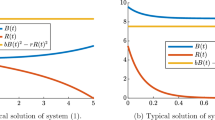Abstract
This paper proposes a Lanchester-type combat model to simulate battles in which one or two of the opposing sides cannot use all the forces simultaneously due to some physical restriction (i.e., topographic constraints, transforming the battlefield into a bottleneck). We show that this model, when the bottleneck restriction applies to both sides, leads to the Lanchester’s linear law for both aimed- and unaimed-fire, but the rate of change over time is a constant. The main characteristics of the bottleneck combat model are the following: (1) the topographic constraint makes the quality (fighting effectiveness) and size of the restriction the more relevant factors for the outcome of the battle, reducing the relative importance of quantity; (2) the bottleneck transforms the Lanchester’s square law into the linear law under direct-fire; and (3) if quality is similar among foes, the topographic bottleneck restriction is irrelevant for victory. The model is used to simulate the Battle of Thermopylae and shows that if the bottleneck restriction had persisted and was not removed, the Persian army would have been defeated.


Similar content being viewed by others
References
Allen P (1992) Situational force scoring: accounting for combined arms effects in aggregate combat models. RAND, Santa Monica
Allen P (1995) The need to represent a wide variety of battle types in air-ground combat models. Mil Oper Res 1:19–25
Armstrong MJ (2014) Modelling short-range ballistic missile defense and Israel’s Iron Dome system. Oper Res 62:1028–1039
Bracken J (1995) Lanchester models of Ardennes campaign. Nav Res Logist 42:559–577
Bury JB (1951) A history of Greece to the death of Alexander the Great, 3rd edn. MacMillan, London
Campbell NCG, Roberts KJ (1986) Lanchester market structures: a Japanese approach to the analysis of business competition. Strateg Manag J 7:189–200
Cassin-Scott J (1977) The Greek and Persian wars 500–323 BC. Osprey Publishing, Oxford
Chalikias M, Skordoulis M (2017) Implementation of F.W. Lanchester’s combat model in a supply chain in duopoly: the case of Coca-Cola and Pepsi in Greece. Oper Res 17:737–745
Chen PS, Chu P (2001) Aplying Lanchester’s linear law to model the Ardennes Campaign. Nav Res Logist 48:653–661
Darilek R, Perry W, Bracken J, Gordon J, Nichiporuk B (2001) Measures of effectiveness for the information-age army. RAND, Santa Monica
David I (1995) Lanchester modeling and the biblical account of the battles of Gibeah. Nav Res Logist 42:579–584
De Souza P (2014) The Greek and Persian wars 499–386 BC. Osprey Publishing, Oxford
Deitchman SJ (1962) A Lanchester model of guerrilla warfare. Oper Res 10(6):818–827
Doyle P, Bennet MR (2002) Fields of battle, terrain in military history. Kluwer Academic Publishers, Dordrecht
Erickson GM (1985) A model of advertising competition. J Mark Res 22(3):297–304
Flores JC (2016) Trojan War displayed as a full annihilation–diffusion–reaction model. Phys A 467:432–435
Flores JC, Bologna M (2013) Troy: a simple nonlinear mathematical perspective. Phys A 392:4683–4687
Franks NR, Partridge LW (1993) Lanchester battles and the evolution of combat in ants. Anim Behav 45(1):197–199
Fricker RD (1998) Attrition models of the Ardennes campaign. Nav Res Logist 45:559–577
Hausken K, Levitin G (2011) Shield versus sword resource distribution in K-round duels. Cent Eur J Oper Res 19:589–603
Hausken K, Moxnes JF (2000) The microfoundations of the Lanchester war equations. Mil Oper Res 5:79–99
Hausken K, Moxnes JF (2002) Stochastic conditional and unconditional warfare. Eur J Oper Res 140:61–87
Hausken K, Moxnes JF (2005) Approximations and empirics for stochastic war equations. Nav Res Logist 52:682–700
Hirshleifer J (1991) The technology of conflict as an economic activity. Am Econ Rev 81:130–134
Holland T (2006) Persian fire: the first world empire and the battle for the west. Doubleday, New York
Hornblower S, Spawforth A (1996) The Oxford classical dictionary, 3rd edn. Oxford University Press, Oxford
Hughes WP (1995) A salvo model of warships in missile combat used to evaluate their staying power. Nav Res Logist 42:267–289
Kraft JC, Rapp G, Szemler GJ, Tziavos C, Kase EW (1987) The pass at Thermopylae, Greece. J Field Archaeol 14:181–198
Kress M, Caulkins JP, Feichtinger G, Grass D, Seidl A (2018) Lanchester model for three-way combat. Eur J Oper Res 264:46–54
Lanchester FW (1916) Aircraft in warfare. The down of the fourth arm. Constable and Company Limited, London
Maurice F (1930) The size of the army of Xerxes in the invasion of Greece 480 BC. J Hell Stud 50:115–128
Morse P, Kimball G (1951) Methods of operations research. The MIT Press, Cambridge
Shanahan L, Sen S (2011) Dynamics of stochastic and nearly stochastic two-party competitions. Phys A 390:1800–1810
Taylor JG (1983) Lanchester models of warfare, vol I and II. Operation Research Society of America, Arlington
Vouvalidis K, Syrides G, Pavlopoulos K, Pechlivanidou S, Tsourlos P, Papakonstantinou MF (2010) Palaeogeographical reconstruction of the battle terrain in Ancient Thermopylae, Greece. Geodin Acta 23:241–253
Winters HA (1998) Battling the elements, weather and terrain in the conduct of war. Johns Hopkins University Press, Baltimore
Acknowledgements
We are grateful to three anonymous referees and the editor for very helpful comments and suggestions on a previous version of the paper. Funding was provided by Spanish Ministry of Science and Tecnology (Grant No. ECO2016-76818-C3-2-P).
Author information
Authors and Affiliations
Corresponding author
Ethics declarations
Conflict of interest
The authors declare that they have no conflict of interest.
Additional information
Publisher's Note
Springer Nature remains neutral with regard to jurisdictional claims in published maps and institutional affiliations.
Rights and permissions
About this article
Cite this article
Bongers, A., Torres, J.L. A bottleneck combat model: an application to the Battle of Thermopylae. Oper Res Int J 21, 2859–2877 (2021). https://doi.org/10.1007/s12351-019-00513-0
Received:
Revised:
Accepted:
Published:
Issue Date:
DOI: https://doi.org/10.1007/s12351-019-00513-0




